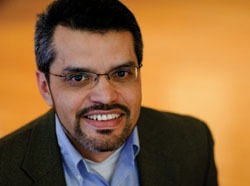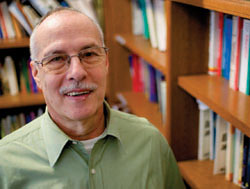Outsourcing the District Office
Schools are no longer being run from the central HQ. The results aren't quite what was expected
Sitting in his car on a busy New Orleans street corner one morning last year, Henry Levin counted no fewer than 17 school buses going by, each serving a different school.
To Levin, the William Heard Kilpatrick Professor of Economics and Education at Teachers College, it was one sign among many that, since Hurricane Katrina in 2005, there have been dramatic changes in the city’s educational landscape.
Much was wrought by the storm itself. Katrina destroyed a third of all school buildings in New Orleans and damaged most of the rest. With the city’s population cut by 80 percent, the schools were closed, and nearly all New Orleans public school employees were laid off.
But even before Katrina, New Orleans’ schools were due for an overhaul. More than 90 percent of the city’s students were failing high school exit exams in both reading and mathematics. Deficits and corruption were widespread. In 2003, the state of Louisiana had established a new entity called the Recovery School District with the charge to “attempt to reconstitute schools with high student failure,” and New Orleans’ public schools were its prime target.
So when Katrina quite literally wiped the slate clean, the reforms undertaken were radical. Today, the New Orleans public schools are no longer run by New Orleans—the city now operates only four schools and administers 12 charters, while all the rest are controlled by the state, either by way of its Recovery School District or other entities. More than half of all remaining schools are now autonomous charter schools, and most of the rest are magnet schools or other alternative-type institutions. And there are no more “catchment zones”: residents can choose to send their children to any school in the city.
The jury is still out on whether these changes are resulting in a better education for New Orleans students. There are some shining examples of innovation, but also—as the proliferation of school buses suggests—a pervasive lack of cohesion. To Levin, about all one can conclude right now is that “they’re building the plane as they’re flying it.”
New Orleans may be an extreme case, but it’s indicative of a trend percolating nationwide, especially where states and strong mayors have taken the lead. A number of large districts are replacing centralized management of day-to-day school operations with more of a “weed-and-seed approach,” closing failing schools and recruiting new types of schools to replace them. These new authorities are overseeing what have come to be called “portfolio districts”: mini-systems of independently operating schools, including traditional public schools with more control over their own budgets, for-profit and nonprofit groups running or partnering with schools on a contract basis, and charter schools, some operating independently and some part of national charter management networks.
“The central office becomes like a general contractor who hires and fires plumbers and electricians and the like, but doesn’t build the house,” says Jeff Henig, Professor of Political Science and Education and the coordinator of the Politics and Education Program at TC.
In Philadelphia, for example, the school reform commission (appointed by the city and the state) contracted with for-profit providers, nonprofits and universities to take over management of 45 schools. Chicago’s Renaissance 2010 plan, announced in June 2004, has launched more than 80 new schools under guidelines that call for closing under-performing schools and replacing them with schools that have been “given autonomy to create innovative learning environments using…charter, contract or performance” as their governance structure. In New York, all 1,400 schools now self-affiliate into networks and “purchase” support services from nonprofit or public “School Support Organizations” (SSOs). These services include principal training, leadership development, teacher development, on-site coaching and development, data analysis, youth development services and technical assistance for special education.
Nationwide, Henig says that during the 2005–2006 school year (the most recent for which data is available), 51 for-profit education management organizations (EMOs) already were managing 521 schools in 28 states plus the District of Columbia. On the not-for-profit side, according to one estimate Henig quotes, by 2015 nonprofit charter management organizations will have created more than 450 schools serving 212,000 students.
And these trends will now be given impetus at the federal level, as well. To be eligible for the new “Race to the Top” education stimulus funding created by the Obama administration, states must agree to lift numerical caps on charter school creation.
Teachers College policy researchers have been in the forefront of analyzing these developments and educating elected officials and policymakers about their current and potential impact. In the fall of 2008, Henig and Levin, along with Katrina Bulkley of Montclair State University, convened a conference of scholars with a grant from the Spencer Foundation to take a closer look at the growing phenomenon of portfolio districts. They are now compiling a book that will include chapters on the experiences of Philadelphia, Chicago, New Orleans and New York. Levin will be the lead writer on the New Orleans chapter while Henig and TC doctoral student Jonathan Gyurko, an expert on New York’s charter schools, are writing about New York City. And, in separate work, Luis Huerta, TC Associate Professor of Education and Public Policy and an advisor to the National Council of State Legislatures, is taking a close look at the way charters are faring under the new systems as part of a continuing series of articles on charters in New York City.
All four men find much to hope for in the idea of portfolio districts. Yet with the growing appetite for charters, all four also have concerns.
“New York has a law governing charter school creation, and charters continue to expand, but we don’t have a state or a city commitment to examine what’s going on in these charters,” says Huerta. “And I think that’s really important because in the end, this is still an experiment.”
What are potential negatives of portfolio districts? Paradoxically, even as they promote autonomy on some levels, portfolio districts also impose frameworks that may actually limit the much-touted entrepreneurial freedom that reformers argue is a prerequisite for success.
In New York City’s unique implementation of portfolio management, Mayor Michael Bloomberg and Education Chancellor Joel Klein have created a support framework for schools that includes SSOs, which fill the roles district offices once played. In theory, SSOs are an improvement over the traditional district structure because schools select their SSO, and the quality of services is measured by principal satisfaction surveys.
But according to research by Henig and Gyurko, real-world interactions between SSOs and client schools are playing out a bit differently. For one thing, the SSOs sign contracts with the New York City Department of Education, not with individual principals or schools—so their accountability to clients still isn’t direct. For another, few SSOs offer all of the services that schools typically require, making true comparison “shopping” more difficult. (For example, two-thirds do not offer assistance with gifted and talented students or instruction in the arts.)
“A truly competitive marketplace needs a lot of providers and choices,” Gyurko says. “The city’s not there just yet.”
Charter schools aren’t required to work with SSOs, but the alternative may threaten their autonomy in a different way. Huerta is finding that in New York, the city puts pressure on charters—which typically receive less funding than other city schools, despite being responsible for covering the costs of their own physical plants—to forge ties with foundations and educational management organizations with deep pockets. However, charters who choose to retain strong ties to their local community and promote the goals of building civic capacity risk losing the autonomy necessary to their locally oriented goals.
“When mom-and-pop charters engage in partnerships with local museums or small community-based organizations, there’s a low risk to their school autonomy in exchange for the in-kind services they receive, but a potential high yield in building civic capacity in their community,” Huerta says. “These types of organizations don’t have the resources or the personnel to demand that a liaison from their organization be appointed to the charter’s school board in order to oversee that their resources are being used wisely. But when charters seek large grants from foundations and other organizations, it’s very likely a foundation will want to appoint somebody to the charter school board. And the investment of countless hours in applying for grants is
also a high tax on charters’ limited staff and human resource capacity.”
also a high tax on charters’ limited staff and human resource capacity.”
Yet taking that risk may be the lesser of two evils. “In New York City, you’re at risk of not being re-chartered if you haven’t secured substantive resources from external partnerships,” Huerta says. “It’s not explicit policy but it’s happening, in so far as who’s being reauthorized and who’s not. Charter schools that seek reauthorization but have yet to secure a partnership with a foundation or management organization may lose the authority to manage their own budget.” Huerta says that two schools he and his colleagues have studied were stripped of their autonomy to make budget decisions over $60,000 because of their failure to demonstrate “additional resource flows” from formal partners.
An added attraction of charters is their potential to function as laboratories for innovative education practices that can then be shared with other schools, thereby improving the entire system. But according to Huerta, charters’ approach in New York City tends to amount to a stringent “three Rs” emphasis, with little sharing with other schools. Ultimately, Huerta says, charters and the organizations that manage them are excelling mainly as team players more adept at meeting traditional accountability standards set by the city and mimicking traditional governance structures and teaching practices than they are at innovating.
Meanwhile, the burden of coming up with new solutions to problems seems to have been shifted to school management organizations and SSOs—or on occasion (for example, the recent ban on student cell phones and the systemwide hiring freeze), simply to the Mayor himself.
“Under a disciplined notion of school autonomy, we’d see schools adopting a variety of policies,” Gyurko says. “But at times, systemic obligations or the Mayor’s prerogative have taken precedence, and the next day it’s policy—citywide.”
Indeed, one of the most persistent criticisms of portfolio management is that, in addition to removing the bureaucracy, it takes the organized public out of the public schools.
“Those behind these new models are trying to shift away from what they consider to be the historical over- responsiveness to teachers unions and the most mobilized parents,” says Henig. The view of these advocates, Henig says, is that increasing the role of education entrepreneurs, nonprofit providers, reformers and experts “can raise expertise and, in the process, better meet the needs of the silent majority of parents who may not be so well represented among the more vocal advocacy groups.”
Boosters of this approach claim they have succeeded in getting the politics out of the system—but not everyone agrees that’s entirely true, or that when it is true, it’s a good thing.
“It took a tremendous amount of politics to do what they’ve done,” says Gyurko of the changes in New York City. “The questions are, whose politics are out? Has practitioner and parent voice been too much removed from the public discourse? And what’s the consequent impact on policymaking?”
The diminishment of the public’s role has been even more significant in New Orleans where, following Katrina and the reorientation of the schools, the entire teacher population was let go, contributing to (among other results) the disempowering of the powerful, largely African American middle class they represented. The new teacher population, according to Levin’s research, is largely drawn from a younger pool, many of them eager Teach for America recruits who, though they provide a bright spark to the system, disappear once their terms are up, forming no permanent ties to the community. Even the chief executive officer of the Recovery School District, Paul Vallas, a veteran of portfolio district creation in Chicago and Philadelphia, commutes back to Illinois on weekends. And Levin is concerned that funding for the system, much of it from outside sources, may disappear once the public focus on New Orleans’ troubles wanes.
Unlike in New York, the New Orleans system’s lack of a strong central authority has created major problems in matters as mundane as communication about which schools have available seats.
“When each school is given maximum autonomy the differences that arise can have just the opposite consequences for the system as those that were intended,” Levin writes. “How can students switch schools if curriculum and school practices vary so immensely from one school to another that there is little or no articulation or possibility of student transition for many students? How can schools compete for teachers who must relinquish valued accumulation of pension and other benefits when switching to a school with different arrangements? Good choices require good information. How will the overall system collect accurate information on school options and disseminate it to students, parents and teachers? Access to choice requires transportation. But school vehicles crisscrossing the entire city are redundant, environmentally damaging and costly, leaving fewer resources to be spent on instruction.”
Building an organized system based on autonomous parts is at the very least counterintuitive. The qualities of charters that the systems hope to maintain may in fact be antithetical to the expansion and replication necessary to apply the model to an entire city. Charters often depend on the vitality of the original cast of teachers and administrators starting the schools. Is it possible to maintain that vitality once those original casts leave or are sent on to try to replicate their school’s success in other schools? “Many charter founders rely on their collective sweat equity to act as the glue that holds their schools together,” says Huerta. “But sweat equity is as liquid as sweat.”
Perhaps the strongest hope of all four men is that the systems be allowed to develop into solutions individually appropriate to each district. “Almost no one out there thinks that these large urban school districts have been doing as well as they should be doing, and portfolio districts represent a serious effort to restructure them,” Henig says. “There’s a potential here to undo a lot of inefficiencies, eliminate a lot of little political fiefdoms, reduce the role of patronage, provide greater voice to groups that haven’t been politically active, and that can be good. What I’m concerned about is when the proponents offer these things as universal, self-enforcing solutions. They seem to believe you can take this model and inject it into this district or this other district and you’re going to get the same results. And that’s not been the case.”
Published Thursday, Apr. 1, 2010





